This fermented hot sauce recipe is a delicious and simple hot sauce with a complexity of flavors and beneficial probiotics. Spicy and tangy, this recipe will give any dish a nice kick of heat.
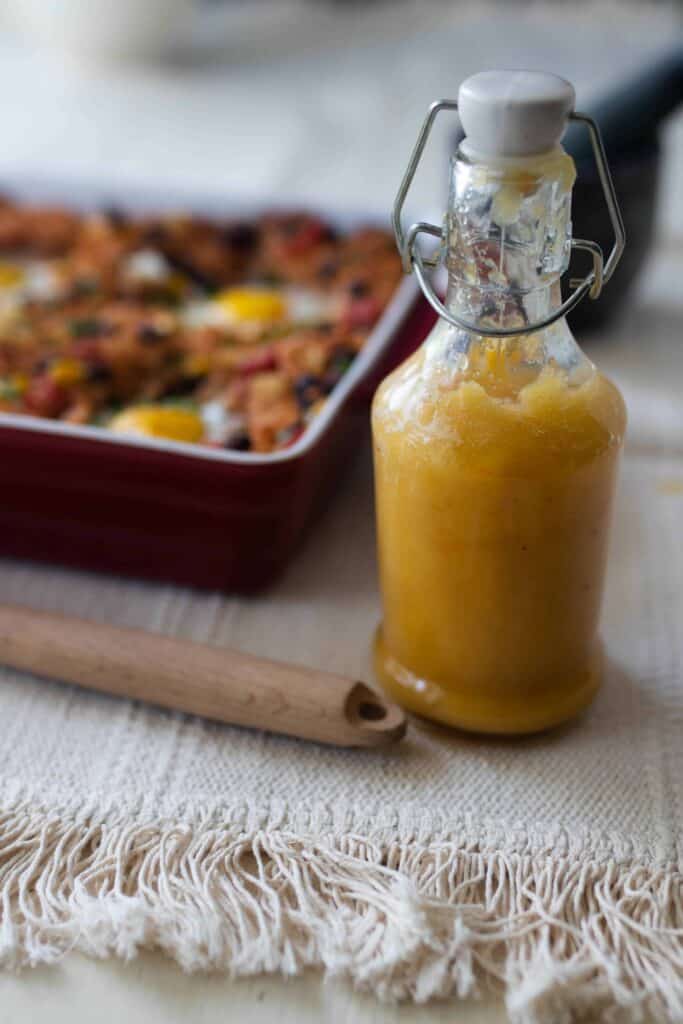
We are no strangers to spicy foods. We absolutely love adding fermented jalapeños to sourdough pizza with a hint of sweetness from some date paste.
Or topping tacos with some fermented salsa (I make a spicier version for Luke and I). Yum!
If you want a real kick of delicious and spicy flavor, you need to make this fermented hot sauce.
There is a flavor complexity that is much more interesting (and delicious) than the non-fermented version.
Fermenting the hot peppers in a salt brine creates beneficial bacteria and yeast that adds a delightful tang to the peppers.
Add this delicious and healthy sauce to your favorite dishes. From eggs to avocado toast, fajitas, white chicken chili, pizza, pumpkin sheet pan nachos, your favorite Asian-inspired dishes, chili, and so much more.
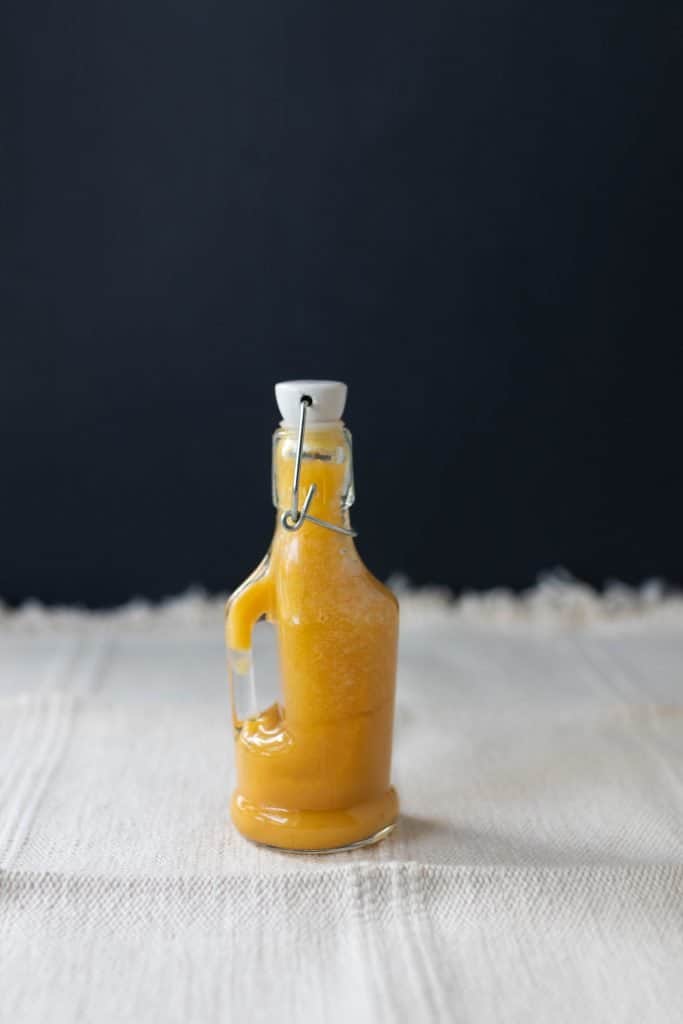
Tips:
- It’s important to keep the peppers submerged in the brine. The easiest way to do this is by using fermentation weights or add water to a plastic storage bag and place it inside the jar.
- Use non-iodized salt when fermenting. Peppers do better with a 3% brine rather than the typical 2% brine, because peppers are more prone to mold growth.
- For ferments, you will want to use filtered or distilled water. I always use my Berkey water filter. This is because city tap water often contains chlorine which can kill the beneficial bacteria.
- I use a kitchen scale for fermenting vegetables, because it takes out so much of the guesswork and cuts down on food waste from ferments that go south.
- If you choose really hot peppers, be sure not to touch your eyes and consider wearing gloves.
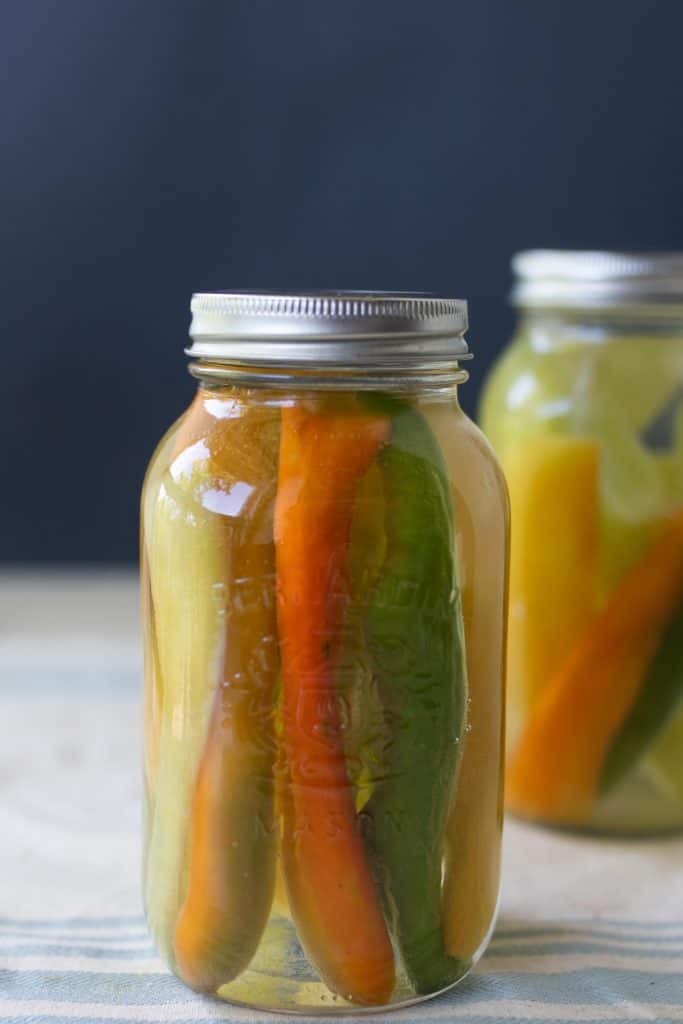
Frequently Asked Questions
Ferments are full of beneficial bacteria and yeasts. Not only that, but the fermentation process adds another level of flavor complexity.
It is better on a few different levels. It has more tang and flavor than the non-fermented versions, and it’s also better for your health, since it contains gut-healthy probiotics.
No. The spiciness will actually mellow out with age, while other flavors will become more complex.
This will last up to 12 months in the refrigerator. Before using, look for any signs of mold. It should have good color and not have any off-putting smells. If in doubt, toss it out.
No. Cooking will destroy all the beneficial bacteria and yeast. Some recipes recommend it, but then you are destroying the part you were waiting for!
Yes. After the fermentation process has happened, you want to slow it down by storing it in the fridge. Ferments that go too long are not very tasty and can mold.
Something called Kahm yeast may appear at the top of your ferment. It looks like a white film and it is typical in vegetable ferments. If the brine is cloudy that’s totally normal.
This post contains affiliate links, which means I make a small commission at no extra cost to you. See my full disclosure here.
Tools You May Need:
Mason jars
Pickle Pipes – I love these.
Blender
Knife
Cutting board
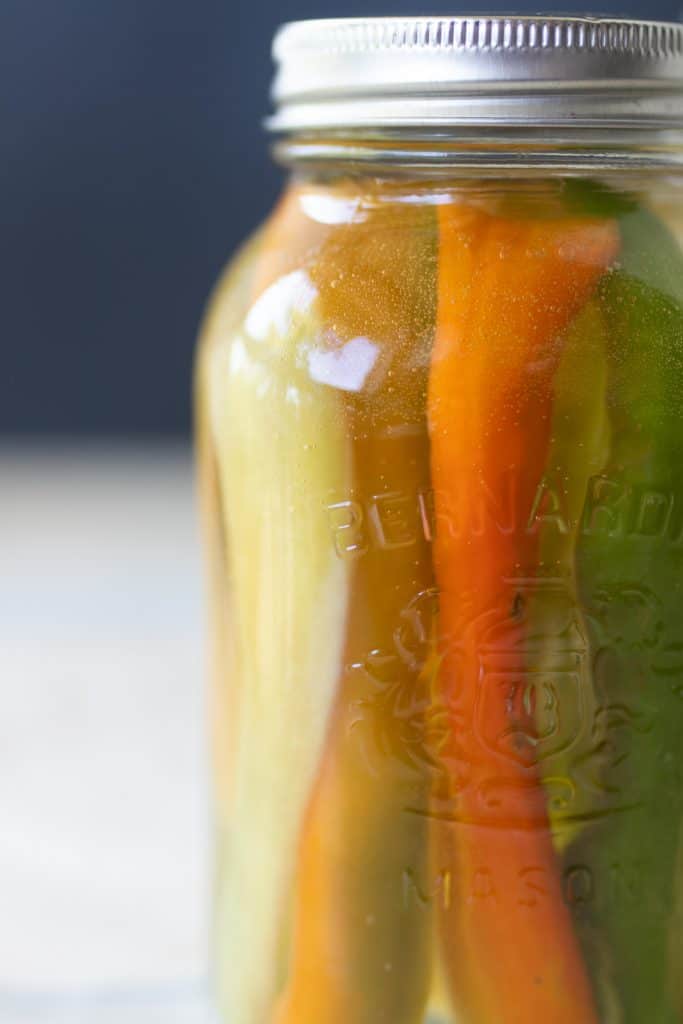
How To Ferment Peppers
Choose which peppers you’d like to ferment. I chose a combination of anaheim peppers and ‘yellow hot’ peppers.
- Fresno chili peppers are very popular for hot sauce and have a beautiful red colour.
- Jalapenos are another great choice.
Prepare the peppers for fermenting: remove stems, slice in half, remove seeds if you wish.
- The heat in chilies is found primarily in the ribs, not the seeds.
- You may want to remove the ribs, as well, if you want a milder hot sauce.
You will need 3% salt brine to have a successful fermentation when fermenting peppers.
Using a kitchen scale, weigh your peppers and distilled water (minus the weight of the jar) to determine how many grams of salt you need. Example: If the peppers and water combined weigh 900 grams, then you’ll need to
add 27 grams of salt. (900 x .03 = 27).
Usually, I use about 4 tablespoons of salt per 1/2 gallon of water. Heat up about 2 cups of water until warm and stir in salt to dissolve.
Add salt water mixture to remaining water and then pour over the peppers in the mason jar, making sure to leave some head room.
Add a fermentation weight and ensure the peppers are below the brine.
Seal the jar loosely, because the contents will bubble and the air bubbles will need to escape.
Taste your ferment after three days to see how it’s progressing. I fermented my last batch of peppers for five days. Depending on the temperature of your house, it may take anywhere from three to seven days.
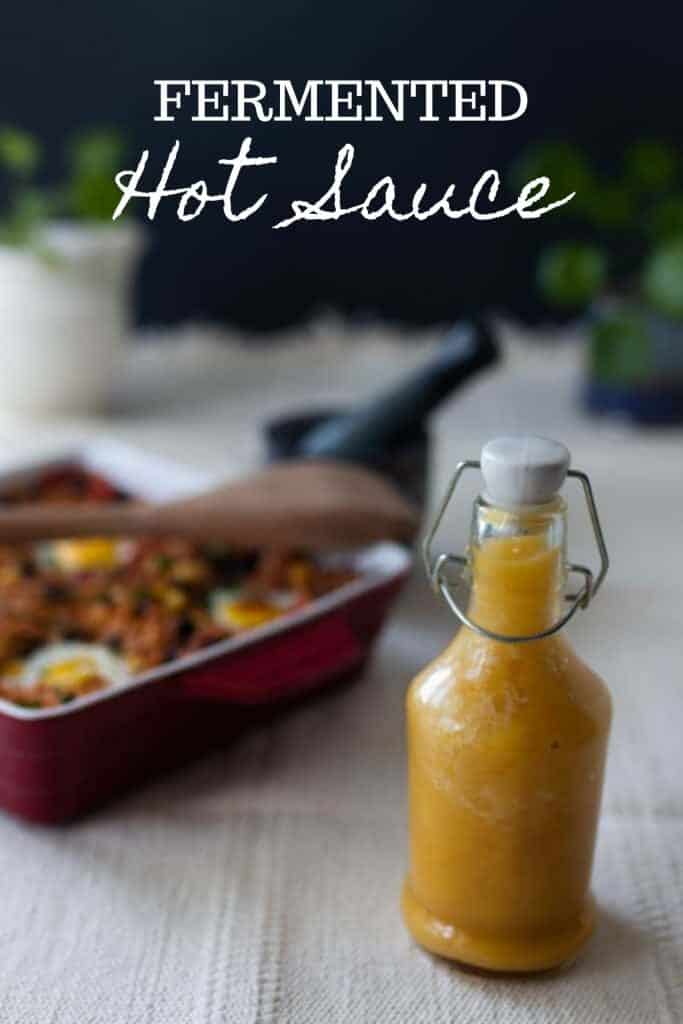
How To Make Fermented Hot Sauce:
Strain off the liquid from the fermented peppers and reserve in another container.
Roughly chop peppers and combine in a blender with brine from your ferment, plus vinegar, sugar, and oil.
Purée in a blender until very smooth, and then taste and adjust salt if necessary.
This is your opportunity to get creative and add other flavours, such as ginger, garlic, lemon, etc.
Find More Fermented Foods And Drinks:
- Water Kefir Soda
- How To Ferment Fruit
- Fermented Garlic
- How To Make Milk Kefir
- How to Make Fermented Carrots
If you make this recipe and love it, I would love if you gave it 5 stars! Tag me on Instagram @farmhouseonboone with your delicious creation.
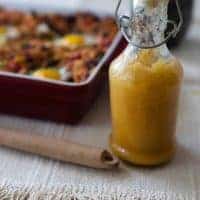
Fermented Hot Sauce
Ingredients
Fermented Peppers
- Hot peppers – Anaheim Fresno, jalapeño, or a combination
- Salt
- Filtered or distilled water
Hot Sauce Ingredients
- 400 grams fermented hot peppers approx 4 cups of roughly chopped pepper
- 3-4 tablespoons saved ferment brine **less is more so that the final product is not too watery
- 2 tablespoons white vinegar or apple cider vinegar
- 1-2 teaspoon organic cane sugar
- 4 tablespoons neutral tasting oil
- Salt to taste
Instructions
Ferment The Peppers
- Choose which peppers you’d like to ferment. I chose a combination of anaheim peppers and ‘yellow hot’ peppers. Fresno and jalapeño are another great choice.
- Remove stems, slice in half, remove seeds if you wish.Remove the ribs and seeds if you want a milder hot sauce.
- You will need 3% salt brine to have a successful fermentation when fermenting peppers.
Using a kitchen scale, weigh your peppers and filtered water (minus the weight of the jar) to determine how many grams of salt you need. Example: If the peppers and water combined weigh 900 grams, then you’ll need to add 27 grams of salt. (900 x .03 = 27) - Usually, I use about 4 tablespoons of salt per 1/2 gallon of water. Heat up about 2 cups of water until warm, and stir in salt to dissolve.
Add salt water mixture to remaining water and then pour over the peppers in the mason jar making sure to leave some head room.
Add a fermentation weight and ensure the peppers are below the brine. - Seal the jar loosely or use a pickle pipe, to accommodate for bubbles during fermentation.
Taste your ferment after three days to see how it’s progressing. Depending on the temperature of your house, it may take anywhere from three to seven days.
How To Make Fermented Hot Sauce:
- Strain off the liquid from the fermented peppers and reserve in another container. Roughly chop peppers and combine in a blender with brine from your ferment, vinegar, sugar, and oil. Purée in a blender until very smooth, and then taste and adjust salt if necessary. This is your opportunity to get creative and add other flavours, such as ginger, garlic, lemon, etc.
Notes
Suggestions for various add ins:
- 1 tsp of lemon juice and zest from half a lemon
- Roasted garlic
- Garlic and/or onion powder
- Ginger
- Pink peppercorns
- Xanthan gum if you desire a thicker hot sauce
Nutrition
Pin It For Later
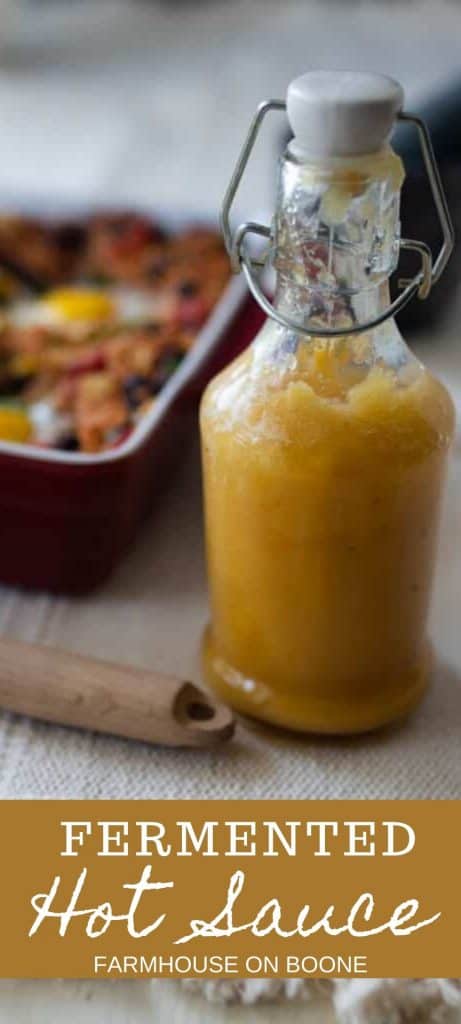

Hélène says
What are some names of “yellow hot” peppers?
How much xanthan gum did u add to get the jar of yellow sauce pictured in the swing top bottle?
Christine says
I have quite a few chili peppers. Does it make sense to ferment in one huge jar, blend, then separate the sauce into smaller jars? How would you store so much sauce? Fridge? Shelf? Canning? I’m brand new to fermentation 😛
Rita says
This is day 5 ,used Himalayan salt
Rita says
Made the fermented peppers , but peppers have a bit of white stuff on them . Is that normal, or have I messed up
Polica McCauley says
I’m going to try to make this fermented hot sauce! Sounds delicious and nutritious 🙌
Bernice Fullilove says
Thank you for all the information on fermenting peppers, it a big help with a great understanding and picture work also. I enjoy your emails and keep up the great work and stay cool.
Lisa says
you’re so welcome! I’m so glad that my content is helpful to you